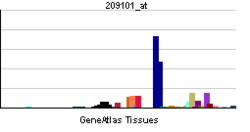- CTGF
-
CTGF (connective tissue growth factor) is a cysteine-rich, matrix-associated, heparin-binding protein. In vitro, CTGF mirrors some of the effects of TGF beta on skin fibroblasts, such as stimulation of extracellular matrix production, chemotaxis, proliferation and integrin expression. CTGF can promote endothelial cell growth, migration, adhesion and survival and is thus implicated in endothelial cell function and angiogenesis[1].
CTGF binds to perlecan[2], a proteoglycan which has been localised in synovium, cartilage and numerous other tissues.
CTGF has been implicated in extracellular matrix remodelling in wound healing, scleroderma and other fibrotic processes, as it is capable of upregulating both matrix metalloproteinases (MMPs) and their inhibitors (TIMPs). Therefore, CTGF has the potential to activate both the synthesis and degradation of the extracellular matrix.
Knockout mice which have had the gene for CTGF removed do not develop normally. Impaired chondrocyte proliferation, angiogenesis, extracellular matrix production and turnover leads to abnormal skeletal growth.[3]
Interactions
CTGF has been shown to interact with Vascular endothelial growth factor A.[4]
See also
References
- ^ Brigstock DR (2002) Regulation of angiogenesis and endothelial cell function by connective tissue growth factor (CTGF) and cysteine-rich 61 (CYR61). Angiogenesis 5:153-165.
- ^ Nishida T et al. (2003) CTGF/Hcs24, hypertrophic chondrocyte-specific gene product, interacts with perlecan in regulating the proliferation and differentiation of chondrocytes. J Cell Physiol 196:265-275.
- ^ Ivkovic S et al. (2003) Connective tissue growth factor coordinates chondrogenesis and angiogenesis during skeletal deveopment Development 130:2779-2791.
- ^ Inoki, Isao; Shiomi Takayuki, Hashimoto Gakuji, Enomoto Hiroyuki, Nakamura Hiroyuki, Makino Ken-ichi, Ikeda Eiji, Takata Shigeo, Kobayashi Ken-ichi, Okada Yasunori (Feb. 2002). "Connective tissue growth factor binds vascular endothelial growth factor (VEGF) and inhibits VEGF-induced angiogenesis". FASEB J. (United States) 16 (2): 219–21. doi:10.1096/fj.01-0332fje. PMID 11744618.
-
- Gressner OA and Gressner AM. Connective tissue growth factor: a fibrogenic master switch in fibrotic liver diseases. Liver Int. 2008; 28:1065-1079.
Further reading
- Brigstock DR (1999). "The connective tissue growth factor/cysteine-rich 61/nephroblastoma overexpressed (CCN) family.". Endocr. Rev. 20 (2): 189–206. doi:10.1210/er.20.2.189. PMID 10204117.
- Abdel Wahab N, Mason RM (2004). "Connective tissue growth factor and renal diseases: some answers, more questions.". Curr. Opin. Nephrol. Hypertens. 13 (1): 53–8. doi:10.1097/00041552-200401000-00008. PMID 15090860.
- Leask A (2004). "Transcriptional profiling of the scleroderma fibroblast reveals a potential role for connective tissue growth factor (CTGF) in pathological fibrosis.". The Keio journal of medicine 53 (2): 74–7. doi:10.2302/kjm.53.74. PMID 15247510.
- George J, Tsutsumi M. (2007). "siRNA-mediated knockdown of connective tissue growth factor prevents N-nitrosodimethylamine-induced hepatic fibrosis in rats.". Gene Ther. 14 (10): 790–803.. doi:10.1038/sj.gt.3302929. PMID 17344905.
Categories:- Human proteins
- Growth factors
Wikimedia Foundation. 2010.

